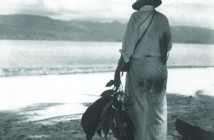THE MISUNDERSTOOD GRAPE
Riesling is one of the most prized grape varietals worldwide, respected by winemakers for its stylized possibilities and gastronomic versatility. In the United States, however, Riesling has been misunderstood for decades as being just another cheap, sweet wine. More often than not, I hear people say “I don’t like Riesling because it’s too sweet,” and yet, ironically, much of the world’s greatest Rieslings are dry. There is also a rare version grown in Germany and Austria, Roter Riesling, which has light red skin that endures slightly warmer climates and produces pinkish-toned wines. Riesling is considered the most compatible wine for culinary pairings because of its varying degrees of sweetness, alcohol and acidity. Personally, I’m unbiased to sweet or dry styles, or even red versus white, since it’s my job to like them all!
One of the special characteristics of the Riesling varietal is its ability to produce white wines ranging in style from bone-dry to semi-dry and semi-sweet to lusciously sweet. Winemakers who cultivate Riesling seldom manipulate the wine with techniques such as barrel aging or blending with other varietals and, instead, focus their efforts on harvesting grape bunches at a specific degree of ripeness to achieve the intended style. There are wineries that experiment with oak aging, but it is an uncommon practice for this varietal. The efforts of winemakers to influence the grapes indirectly simply through natural conditions such as soil, sun exposure and water stress have given Riesling wines the reputation of portraying the flavors of the land in which it is planted.
Riesling is a cool-climate varietal said to have originated in the Mosel Valley of Germany in the early 1400s and continues to maintain its position as the country’s leading grape. Germany has 13 approved wine-producing regions with wines divided into two primary classifications: Qualitatswein, which is an inexpensive, simple wine, and Padikatswein, with six sub-categories based on ripeness at harvest time. The first, Kabinett, is a crisp, young wine with notes of citrus fruit, minerality and a vibrant acidity that pairs deliciously with light cheeses, cold meats and grilled seafood. The second, Spatlese, meaning “late harvest,” has a bouquet ranging from peaches to rose blossom. I find Spatlese’s off-dryness to be the happy medium for many palates while complementing seasoned meats, spicy foods and oriental cuisine.
Next is Auslese, which is rich in flavors such as yellow plum and toasted almond and pairs particularly well with intensely flavored foods such as blue cheese, smoked duck, concentrated meat stocks and dishes with cream sauces or butter reductions. Many Ausleses can age for well over a decade. As some Rieslings mature, the wine can acquire a slight petrol scent, which imparts a pleasant uniqueness in flavor that distinguishes it from other grape varietals. While I was doing my MBA, I had a wine partner who was just as adventurous as I in trying new wines. The more stressful the project, the more money we would set aside for the celebratory bottle. One of my most delicious memories was drinking J.J. Prum Auslese, which had flavors of tangy apricot and nutty vanilla, subtle hints of mineral and slate, and a silky, lingering finish of baked apple. Heavenly!
The final three are dessert wines, often sweet enough to drink on their own or as accompaniments to tart or fruity desserts. Beerenauslese is made from handpicked ripe grapes for a lusciously sweet result. Eiswein is made from fully overripe grapes frozen onto the vines and then picked and pressed while still frozen in order to produce wines high in acidity and fruit sugar. Canada produces its own tasty version called Icewine. Finally, Trockenbeerenauslese is made from grapes that have ripened, rotted, and dried-up like raisins to create a thicker, deeply concentrated wine that can age gracefully for decades although its low yield and labor-intensive process attach a high price tag.
Riesling continues to be planted on a global scale. The Alsace region of northern France began cultivating Riesling vines in the late 1400s, and, to this day, remains the only French area permitted to plant the varietal. Alsace’s soil is distinctly different from
its neighboring German regions and creates wines with a greater alcohol content, acidity and dryness. Trimbach Winery in Alsace is well-known for its refreshingly dry Rieslings. New Zealand began planting Riesling in the 1970s and has experienced a boom in demand for its light and elegant style. Australia, which has a warmer climate, grows a Riesling clone with a thicker skin to protect itself from the heat, producing wines with flavors of toasty honeycomb and lemon marmalade. In the late 1800s, German immigrants brought the Johannisberg Riesling clone to New York’s Finger Lakes region and have since spread the vines to various regions throughout the United States. Washington State is the top producer of Riesling in the U.S., and its local winery, Chateau Ste. Michelle, leads Riesling sales by volume worldwide.
The Riesling grape’s flexibility in creating an array of wine styles has taken the world by storm in the past few decades. Winemakers in different continents are merging their efforts to create new interpretations of the varietal. Germany’s Dr. Loosen, for example, partnered with Chateau Ste. Michelle to create Eroica Riesling, which has done well amongst consumers. With their great variety, from dry to sweet, accompanied by their region’s distinct flavors, there is a Riesling wine
waiting for you to discover.



